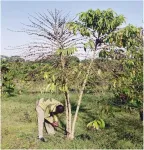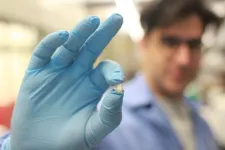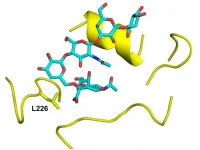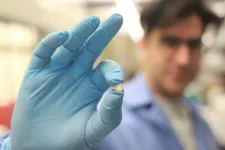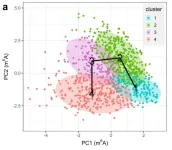(Press-News.org) Scientists, including those from Imperial College London, University of Oxford and CABI, have ‘turned up the heat’ on how repeated outbreaks of coffee wilt disease threatened arabica and robusta varieties of our favourite daily coffee brew.
The scientists, who present their findings in the journal PLoS Biology, say the fungal pathogen Fusarium xylarioides continues to pose a significant threat to coffee production and incomes across sub-Saharan Africa.
Their work supports earlier findings, based on DNA markers and crossing experiments which suggested that F. xylarioides is a species complex containing distinct, host-specific populations.
The scientists confirm the presence of genetically differentiated lineages with different host-specificity for arabica and robusta coffee and show that the fungal pathogen F. xylarioides repeatedly took up “horizontally transferred” segments of DNA from a related fungal Fusarium taxa which contributed to successive outbreaks of the disease.
Primary source of income for more than 12 million households
Coffee is a primary source of income for more than 12 million households in Africa and contributes a significant proportion of tax revenue in a number of these countries, with Ethiopia, for example, recording an export value of $762.8m annually. Yet repeated outbreaks of coffee wilt disease have continued to decimate coffee production in east and central Africa since the 1920s, affecting yields and farmer incomes.
As part of this study, the scientists compared the genomes of 13 historical strains of F. xylarioides spanning six decades from CABI’s Culture Collection, to identify the evolutionary process behind these repeated outbreaks of coffee wilt disease.
Dr Matthew Ryan, Senior Research Lead, Biological Resources at CABI and a co-author of the paper, co-supervised lead author of the research, Dr Lily Peck, of Imperial College London, together with Professor Tim Barraclough from the University of Oxford.
Crucial to understand genetic structure and evolutionary potential
Dr Peck said, “To improve the disease management of fungal pathogens such as Fusarium xylarioides, it is crucial to understand their genetic structure and evolutionary potential.
“We found that F. xylarioides comprised at least four distinct lineages: one host-specific to arabica, one to robusta and two historic lineages isolated from various coffee species.
“The presence/absence of large genomic regions across these lineages showed that horizontal transfers of effector genes, namely genes that are important in establishing successful infection, contributed to establishing host specificity.”
Dr Peck also said that multiple transfers into F. xylarioides populations matched different parts of the Fusarium oxysporum mobile pathogenicity chromosome and were enriched in effector genes and transposons.
Transposons, also known as “jumping genes,” are DNA sequences that can move around in genomes. They are found in many organisms, including bacteria, yeasts, humans, mice, fruit flies and frogs.
Shown by transcriptomics to be highly expressed during infection
Effector genes and other carbohydrate-active enzymes important in the breakdown of plant cell walls were shown by transcriptomics to be highly expressed during infection of arabica coffee by the pathogenic arabica strains.
Professor Barraclough said, “Widespread sharing of specific transposons between F. xylarioides and F. oxysporum, and the correspondence of a putative horizontally transferred region to a Starship (recently identified large mobile elements which are involved in fungal horizontal gene transfers), reinforce the inference of horizontal transfers and suggest that mobile elements were involved.
“Our results support the hypothesis that horizontal gene transfers contributed to the repeated emergence of coffee wilt disease.”
Potentially lucrative export of various coffee varieties
Dr Ryan said the research findings potentially show what is happening more widely in relation to fungi and gives scientists the potential to further build on Dr Peck’s study in the future.
“The fact that horizontal gene transfers between two different species of Fusarium contributed to the repeated emergence of coffee wilt disease is a key mechanism to understand what is happening more widely in fungi – to what extent, we just do not know,” he said.
The scientists suggest that horizontal transfer could have occurred in a ‘shared niche,’ as both F. xylarioides and F. oxysporum are soil-borne pathogens and have been isolated from the roots and wood of coffee wilt-diseased trees in Ethiopia and central Africa, and from the roots of a banana tree in central Africa.
They add that knowledge of horizontal transfer mechanisms and putative donor taxa might help to design future intercropping strategies that minimize the risk of transfer of effector genes between closely related Fusarium taxa.
Full paper reference
Lily D. Peck, Theo Llewellyn, Bastien Bennetot, Samuel O’Donnell, Reuben W. Nowell, Matthew J. Ryan, Julie Flood, Ricardo C. Rodŕıguez de la Vega, Jeanne Ropars, Tatiana Giraud, Pietro D. Spanu, Timothy G. Barraclough, ‘Horizontal transfers between fungal Fusarium species contributed to successive outbreaks of coffee wilt disease,’ PLoS Biol, 5 December 2024, DOI: 10.1371/journal.pbio.3002480
The paper can be read in full here.
END
Scientists ‘turn up the heat’ on understanding coffee wilt disease which threatens our favourite daily brew
Scientists, including those from Imperial College London, University of Oxford and CABI, have ‘turned up the heat’ on how repeated outbreaks of coffee wilt disease threatened arabica and robusta varieties of our favourite daily coffee brew. The scient
2024-12-05
ELSE PRESS RELEASES FROM THIS DATE:
Researchers crack the code of how fish pick their own birthday
2024-12-05
New research has revealed that fish embryos actively control their hatching timing through a neurohormone, Thyrotropin-Releasing Hormone (TRH), which triggers the release of enzymes that dissolve the egg wall. This groundbreaking discovery uncovers a previously unknown neural mechanism that governs a critical life-stage transition, showing that embryos are not passive but instead actively make life-or-death decisions. The finding has significant evolutionary implications, offering new insights into neurobiology, survival strategies, and environmental adaptation in vertebrates.
Dr. ...
Shaking sensor continuously monitors inflammation
2024-12-05
Northwestern University scientists have designed a new implantable device that can monitor fluctuating levels of proteins within the body in real time.
Inspired by fruit shaking off the branches of a tree, the device comprises strands of DNA that stick to proteins, shake them off and then grab more proteins. This creative strategy enables the device to sample various proteins over time to measure changes in inflammatory markers.
In proof-of-concept experiments, the sensors accurately and sensitively measured protein biomarkers of inflammation in diabetic rats. ...
Scripps Research scientists identify mutation that could facilitate H5N1 “bird flu” virus infection and potential transmission in humans
2024-12-05
LA JOLLA, CA—Avian influenza viruses typically require several mutations to adapt and spread among humans, but what happens when just one change can increase the risk of becoming a pandemic virus? A recent study led by scientists at Scripps Research reveals that a single mutation in the H5N1 “bird flu” virus that has recently infected dairy cows in the U.S. could enhance the virus’ ability to attach to human cells, potentially increasing the risk of passing from person to person. The findings—published in ...
Queen Mary University of London vaccination tool boosts uptake of MMR vaccine in children
2024-12-05
A software tool developed by Queen Mary University of London’s Clinical Effectiveness Group (CEG) and used as part of a facilitated quality improvement programme has increased the number of children receiving their first MMR vaccination on time in North East London. The success of this programme highlights the potential of a learning health system and data-driven solutions to enhance public health and improve vaccination uptake across the UK.
An evaluation published in Vaccine revealed that the APL-Imms ...
Implantable sensors unlock ability to continuously monitor inflammation
2024-12-05
Implantable Sensors Unlock Ability to Continuously Monitor Inflammation
The Chan Zuckerberg Biohub Chicago’s milestone achievement tracks protein levels in real time, enabling monitoring of inflammation at the cellular level
Proteins are the building blocks of life, and changes in protein levels can indicate improving health or impending illness, including signs of inflammation. While protein levels can be measured in periodic blood or urine tests, it has been an uphill challenge to figure out how to continuously monitor protein levels in the human body in real time.
Now, a team of bioengineers at Chan Zuckerberg Biohub Chicago, supported by the ...
Buffalo besties: Feral female buffalo build friendships based on similar personality traits
2024-12-05
HONG KONG (29 November 2024)—Similar social personalities strongly influence friendships in humans, yet we know relatively little about how animals choose their friends.
But a new study by researchers at City University of Hong Kong (CityUHK) investigating a unique free-ranging feral population of water buffalo on Lantau Island in Hong Kong has discovered that close spatial proximity serves as an indicator of friendship based on the predictive patterns of certain personality traits.
“Our research provides evidence that friendships among water buffalo can form among individuals with similar behaviours. These findings ...
UNC researchers awarded up to $10M to leverage data science to accelerate cancer diagnosis and optimize delivery of precision oncology
2024-12-05
UNC researchers awarded up to $10M to leverage data science to accelerate cancer diagnosis and optimize delivery of precision oncology
CHAPEL HILL, North Carolina—A team of UNC-Chapel Hill researchers has been awarded up to $10 million in Advanced Research Projects Agency for Health (ARPA-H) funding to develop the Cancer Identification and Precision Oncology Center (CIPOC). The project is designed to improve cancer diagnosis and support personalized treatments by quickly aggregating and analyzing ...
Cardiovascular disease symptoms surprisingly high in young refugees
2024-12-05
Many individuals seeking asylum in the United States show increased stress and pain symptoms that are associated with indications of cardiovascular disease according to Weill Cornell Medicine researchers.
“We would not have expected the rates of these illnesses or conditions to be this high in such a young, otherwise healthy population,” said the study’s senior author, Dr. Gunisha Kaur, associate professor of anesthesiology and an anesthesiologist at NewYork-Presbyterian/Weill Cornell Medical Center.
The study, published Dec. 5 in Nature Mental Health, analyzed medical evaluations from 453 U.S. asylum seekers for symptoms associated with psychological ...
To remember conversations, keep making new brain cells
2024-12-05
Why do adults make new brain cells? A new study published in Cell Stem Cell provides the first cellular evidence that making new brain cells in adults supports verbal learning and memory, which enables people to have conversations and to remember what they hear. This discovery could point to new approaches to restore cognitive function.
The study, led by scientists from USC Stem Cell and the USC Neurorestoration Center at the Keck School of Medicine of USC, relied on brain tissue from patients with drug-resistant cases of mesial temporal lobe epilepsy (MTLE), which involves seizures as well as accelerated cognitive decline.
“Treating patients with epilepsy ...
RNA modifications in individual cells better understood with new modelling
2024-12-05
Researchers have developed a new tool that will help scientists study how genes are expressed in our cells. The tool, called SigRM, is used to analyse data from single-cell epitranscriptomics, a method for studying RNA modifications in individual cells. This research could lead to important insights into health and disease.
Recent advances in single-cell technology have enabled researchers to analyse thousands of individual cells at once, providing rich information about the expression and activity of genes and proteins, as well as chemical changes that affect gene expression. A major tool in these studies is single-cell epitranscriptomics, which studies RNA ...
LAST 30 PRESS RELEASES:
University of Oklahoma researcher awarded funding to pursue AI-powered material design
Exploring how the visual system recovers following injury
Support for parents with infants at pediatric check-ups leads to better reading and math skills in elementary school
Kids’ behavioral health is a growing share of family health costs
Day & night: Cancer disrupts the brain’s natural rhythm
COVID-19 vaccination significantly reduces risk to pregnant women and baby
The role of vaccination in maternal and perinatal outcomes associated with COVID-19 in pregnancy
Mayo Clinic smartwatch system helps parents shorten and defuse children's severe tantrums early
Behavioral health spending spikes to 40% of all children’s health expenditures, nearly doubling in a decade
Digital cognitive behavioral treatment for generalized anxiety disorder
Expenditures for pediatric behavioral health care over time and estimated family financial burden
Air conditioning in nursing homes and mortality during extreme heat
The Alps to lose a record number of glaciers in the next decade
What makes a good proton conductor?
New science reporting guide published for journalists in Bulgaria
New international study reveals major survival gaps among children with cancer
New science reporting guide published for journalists in Turkey
Scientists develop a smarter mRNA therapy that knows which cells to target
Neuroanatomy-informed brain–machine hybrid intelligence for robust acoustic target detection
Eight SwRI hydrogen projects funded by ENERGYWERX
The Lundquist Institute and its start-up company Vitalex Biosciences Announces Strategic Advancement of Second-Generation fungal Vaccine VXV-01 through Phase 1 Trials under $40 Million Competitive Con
Fine particles in pollution are associated with early signs of autoimmune disease
Review article | Towards a Global Ground-Based Earth Observatory (GGBEO): Leveraging existing systems and networks
Penn and UMich create world’s smallest programmable, autonomous robots
Cleveland researchers launch first major study to address ‘hidden performance killer’ in athletes
To connect across politics, try saying what you oppose
Modulating key interaction prevents virus from entering cells
Project explores barriers to NHS career progression facing international medical graduates
Jeonbuk National University researchers explore the impact of different seasonings on the flavor perception of Doenjang soup
Two Keck Medicine of USC Hospitals named Leapfrog Top Teaching Hospitals
[Press-News.org] Scientists ‘turn up the heat’ on understanding coffee wilt disease which threatens our favourite daily brewScientists, including those from Imperial College London, University of Oxford and CABI, have ‘turned up the heat’ on how repeated outbreaks of coffee wilt disease threatened arabica and robusta varieties of our favourite daily coffee brew. The scient
